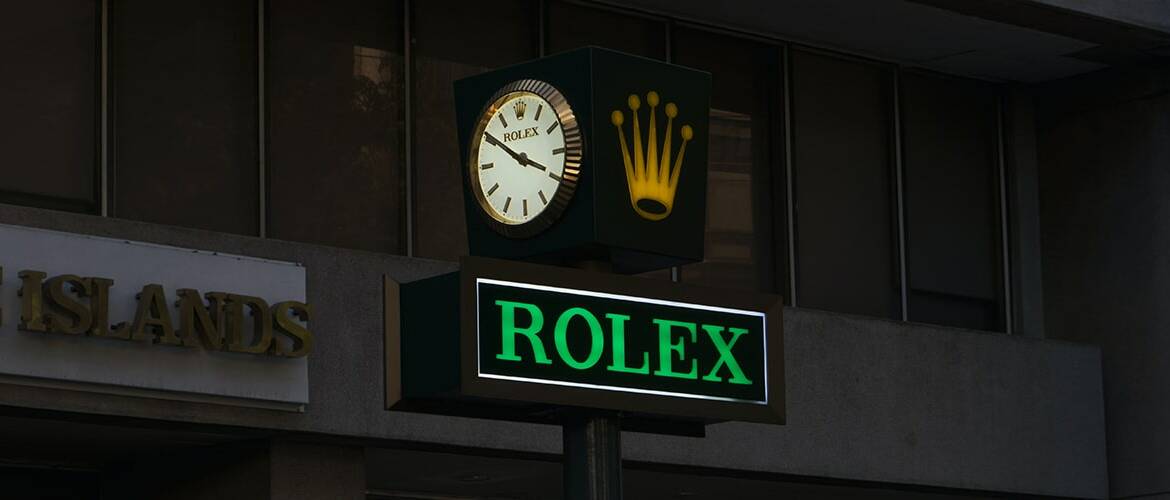Rolex Day-Date Basics: History, Production & Specifications
The Rolex Day-Date, often recognized for its day and date display, is a popular choice for many watch lovers. In this post, we’ll dive into the background of this iconic watch, explore how it’s made, and look at its key features. If you’re keen to learn more about the Day-Date, this is the perfect starting point.
What’s The History Of The Rolex Day-Date?
The Rolex Day-Date, first introduced in 1956, is known for being the first wristwatch to display both the date and the day of the week spelled out in full on its dial. Over the years, it has become an iconic symbol of prestige and success, earning the nickname President’s Watch.
Rolex introduced the Day-Date in 1956, marking a significant step in watchmaking history. This watch was the first to offer both the day of the week and the date on its dial. The day of the week is shown at the 12 o’clock position, while the date is displayed at 3 o’clock under a Cyclops lens for easier reading.
Over the years, Rolex has updated the Day-Date with technological advancements. For instance, the original Day-Date model was equipped with the Caliber 1055 movement featuring a Butterfly rotor. Later models have seen improved movements, with the most recent Day-Date models being equipped with the Caliber 3255 – an automatic, self-winding movement that offers superior precision, power reserve, resistance to shocks and magnetic fields, convenience, and reliability.
The Day-Date’s design has largely remained consistent over the years, reflecting Rolex’s commitment to timeless elegance and function. Today, the Day-Date is available in two sizes: 36mm (reflecting the original size) and 40mm (introduced in 2015 for those preferring a larger watch). The wide array of dial colours and materials, hour marker options, and bezel types also allow for personalization, making the Day-Date a versatile choice for those seeking a watch that combines prestige, luxury, and functionality.
What Type Of Watch Is A Day-Date?
The Rolex Day-Date is a luxury wristwatch that displays both the date and the day of the week. Known for its exclusive use of precious metals and the iconic President bracelet, it’s a symbol of prestige, combining Rolex’s expertise in craftsmanship, precision, and luxury.
Introduced in 1956, the Rolex Day-Date falls into the category of luxury dress watches. It’s known for being the first wristwatch to display the date and the full day of the week on its dial. The date is shown at 3 o’clock under a Cyclops lens, while the day is displayed at 12 o’clock.
Exclusively crafted from 18k gold (yellow, white, or Rolex’s patented Everose gold) or 950 platinum, the Day-Date is often associated with status and achievement. Unlike other Rolex models that also come in stainless steel (like the Submariner, Datejust, or Oyster Perpetual), the Day-Date’s use of only precious metals sets it apart as a symbol of luxury and prestige.
What Is Special About The Day-Date Rolex?
The Rolex Day-Date, introduced in 1956, holds a special place in the realm of horology for several reasons. It’s the first wristwatch that displayed both the day of the week spelled out in full and the date. Known for its exclusive use of precious metals and its iconic President bracelet, the Day-Date is a symbol of prestige and accomplishment.
- Rolex’s Day-Date model made horological history as the first wristwatch to display both the date and the full day of the week on its dial. The day is displayed at 12 o’clock and the date at 3 o’clock, both clearly visible for easy reference. The date is further magnified by Rolex’s signature Cyclops lens.
- Another distinct aspect of the Day-Date is its exclusive use of precious metals. Unlike other Rolex models that are available in stainless steel, the Day-Date is only crafted from 18k gold (yellow, white, or Rolex’s proprietary Everose gold) or 950 platinum. This unique use of only precious metals positions the Day-Date as a high-luxury timepiece and a status symbol.
- The Day-Date is also famous for its President bracelet. Named after the Day-Date’s nickname, the President’s Watch, this bracelet is designed with semi-circular three-piece links, offering both comfort and sophistication. The bracelet, along with the distinctive day and date features, is now an iconic aspect of the Day-Date’s identity.
- From a technical standpoint, the Day-Date houses Rolex’s state-of-the-art movements, offering superior precision, a longer power reserve, and resistance to shocks and magnetic fields.
Overall, the Rolex Day-Date’s distinct features, coupled with its commitment to superior craftsmanship and precision, make it a special and highly sought-after watch. Its rich history, association with influential figures, and Rolex’s dedication to continuous innovation further contribute to its iconic status in the watch industry.
💡 You might like this guide: How Much Is A Day-Date Watch?
What Are The Key Specifications Of A Day-Date Rolex?
The Rolex Day-Date, often referred to as the President’s watch, is a prestigious and iconic timepiece. The Day-Date offers a wide range of dial variations, including classic designs and more intricate patterns. Dials are available in different colours, such as black, silver, blue, champagne, and white. There are also options for diamond-set hour markers or dials with other precious stones.
Here are the key specifications commonly associated with the Rolex Day-Date:
- Case Size: The Day-Date is traditionally available in a 36mm case diameter. However, Rolex has also introduced larger versions, such as the Day-Date II (41mm) and the Day-Date 40 (40mm). It’s important to note that Rolex periodically updates their models, so newer variations may have different case sizes.
- Materials: Rolex offers the Day-Date in various luxurious materials. The case and bracelet options include stainless steel, 18k yellow gold, white gold, rose gold, and platinum. Some models feature combinations of materials, such as two-tone stainless steel and gold.
- Dial Options: The Day-Date offers a wide range of dial variations, including classic designs and more intricate patterns. Dials are available in different colours, such as black, silver, blue, champagne, and white. There are also options for diamond-set hour markers or dials with other precious stones.
- Movement: Rolex equips the Day-Date with their in-house automatic movement, known as the Caliber 3255. This movement offers exceptional precision, reliability, and a power reserve of approximately 70 hours. However, older Day-Date models may feature different movements.
- Day and Date Display: As the name suggests, the Day-Date prominently displays both the day of the week and the date. Positioned at 12 o’clock, the watch features a window displaying the full name of the day, in multiple language options, and a date window at 3 o’clock.
- Waterproofness: Rolex watches, including the Day-Date, are known for their excellent water resistance. While not specifically designed for diving, the Day-Date models are generally water-resistant to a depth of 100 metres (330 feet).
- Bracelet Options: The Day-Date is commonly paired with the iconic President bracelet, characterised by semi-circular three-piece links. The bracelet is crafted in the same material as the case and provides a refined and comfortable fit. Some models may offer alternative bracelet options like the Oyster bracelet or leather straps.
- Crystal: The crystal protecting the dial is made of scratch-resistant sapphire, known for its durability and clarity. In addition, some older models may feature acrylic crystals.
Who Wears Rolex Day-Dates?
The Rolex Day-Date, also known as the President’s Watch, is often seen on the wrists of world leaders, CEOs, celebrities, and influential figures due to its status as a symbol of success and prestige.
The Day-Date was famously worn by several U.S. Presidents, including Lyndon B. Johnson, who is often credited with the President’s Watch nickname. It’s also said that a Rolex Day-Date was part of Dwight D. Eisenhower’s collection, though his was a Datejust model. Additionally, other world leaders and politicians are known to have worn the Day-Date, including Winston Churchill and Chinese President Xi Jinping.
Beyond the world of politics, the Day-Date is popular among business moguls and CEOs, as its high-quality craftsmanship and luxurious design represent success and prestige. It’s also a favourite among celebrities from various fields, including sports, music, and film. Some famous personalities known to sport the Day-Date include Roger Federer, Jay-Z, Ellen DeGeneres, and Jennifer Aniston, to name just a few.
💡 Read more: How To Adjust & Set The Time On Your Rolex Day-Date
How Can You Spot A Fake Rolex Day-Date?
Spotting a fake Rolex Day-Date can be a challenging task, as counterfeiters have become increasingly skilled at producing replicas that closely resemble the genuine timepieces. Genuine Rolex Day-Date watches are high-end luxury timepieces and come with a significant price tag. If the price seems too good to be true or significantly lower than the market value, it should raise suspicion.
However, there are several key indicators you can look out for to help identify a fake Rolex Day-Date:
- Price: Genuine Rolex Day-Date watches are high-end luxury timepieces and come with a significant price tag. If the price seems too good to be true or significantly lower than the market value, it should raise suspicion.
- Weight and Build Quality: Rolex watches are crafted with high-quality materials, such as stainless steel or precious metals like gold or platinum. Counterfeit watches often use inferior materials, resulting in a noticeable difference in weight and build quality. Genuine Rolex watches feel substantial and well-made.
- Cyclops Date Window: The Rolex Day-Date features a magnifying cyclops lens above the date window at 3 o’clock. On genuine Rolexes, the date should be magnified 2.5 times, and the date font should be crisp and clear. Counterfeit models might have a smaller magnification or an improperly aligned date window.
- Movement and Ticking: Authentic Rolex Day-Date watches use automatic movements, often referred to as perpetual movements. The second hand of a genuine Rolex should move smoothly, with a sweeping motion, rather than ticking. Counterfeit watches often have a noticeable ticking motion.
- Logo and Engravings: Examine the Rolex crown logo on the dial and the engravings on the case back. Genuine Rolexes have finely detailed logos with sharp edges, while fakes may have blurry or poorly executed logos. Additionally, Rolex engravings on the case back are generally precise, clean, and deeply etched.
- Cyclops Date Alignment: In genuine Rolex Day-Date watches, the cyclops lens should magnify the date window so that the date is perfectly centred. In replicas, the alignment may be off, with the magnification not precisely centred on the date.
- Serial and Model Number: Every Rolex watch has a unique serial number and model number. Counterfeit watches may have incorrect or poorly engraved numbers, or they might lack them altogether. Genuine Rolexes have clear, well-engraved numbers between the lugs on the side of the case.
- Hologram and Rehaut: Authentic Rolex Day-Date watches feature a hologram-encoded Rolex crown logo on the crystal at 6 o’clock. Counterfeit models may have a poorly reproduced or non-existent hologram. The rehaut, the inner edge of the dial, should also display the words ROLEX and GENEVA multiple times. Counterfeit watches might have shallow or unclear engravings.
⌚️ For more information, check out this guide on how to spot a fake Rolex.

